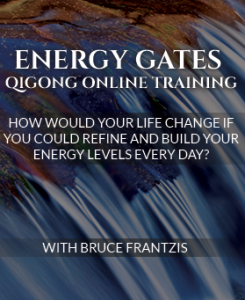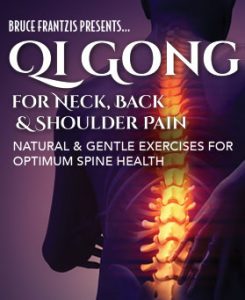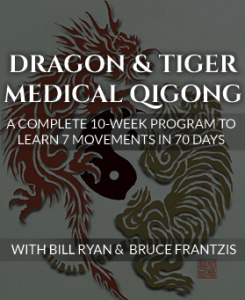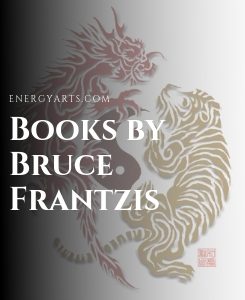The healing of others is one of the five basic applications of Chi Gung, the other four being one’s own health and healing, martial arts, sexual practices, and practices to address the rigors of meditation. Tui Na is the general term for all the hands-on therapies developed by the Taoists, and in some form is a part of most acupuncture school curricula.
Chi Gung Tui Na refers to the energetic therapy techniques, which are rarely taught or understood anywhere in the West. We are fortunate to have received some of these basic techniques through Bruce’s occasional offerings. In this article I hope to concisely describe several essential techniques in a way that will enable the benefits of this Taoist art to reach our clients, friends, and family.
There are two basic skills in all therapy professions (indeed all repair professions): finding out exactly what is the problem and getting it fixed. In medical terms this is Diagnosis and Treatment. The questions are something like, “How do you know what the problems are, what to do, and how do you know if it’s actually working?
I. Listening, Reading, Feeling, “Diagnosing”
You can think of this as an extension of palpation skills, reaching beyond gross physical contact. The simplest way to learn this is to sit quietly and lightly hold someone’s hand and try to feel beneath the skin for constrictions, tension, temperature differences, strength, weakness, whatever doesn’t feel right, etc. Allow your mind to travel up your partner’s arm without repositioning your hand, feeling in 3 dimensions for whatever you can including basic anatomical features.
When you feel something unusual, ask for confirmation, or check it with physical contact. As a variation you can move the body in subtle minute ways, changing angles and pressures, and see what else you find. I sometimes compare this to fishing with a pole and line-with experience you can feel exactly what’s going on at the unseen end.
Listening really needs to be done continuously throughout the therapeutic process. Continuous refinement of your perception skills is perhaps your most important asset for determining when to play with what techniques and how to “tweak” them for better results. Generally we are looking for softening of the physical body which will permit the free flow of fluids and energy so that the whole system will find its natural balances.
II. Therapeutic Techniques, “Treatment”
Theoretically and practically, the effects of stress, strain, ageing, and injury (i.e. the secondary injury after the initial assault) are constriction, tension, hardening, and inflexibility, accompanied by a compromised flow of body fluids and energy itself. To restore the natural, balanced energy flow, the body needs to become soft, open, pliable, and relaxed. Conversely, balancing the energy flow will open the body. Good therapy calls for some combination of the physical and energetic.
It should be noted here that addressing initial injuries such as tears, lacerations, bruises, and inflammations, requires closures and constrictions, i.e. the opposite of opening. These methods are even less well known, and the reader is advised proceed with caution and/or stick to the accepted Western methods of rest, ice, elevation, and maybe compression, rather than risk worsening a condition. (I speak from experience.)
These techniques can be divided into two broad categories: those that are purely energetic, and those that mix energy and physics.
A. Energetic Techniques
Includes those involving little or no physical contact or manipulation.
1. Clearing by Dissolving
Dissolving is the heart of the Taoist Water methods, and is generally learned on oneself first using the mind alone. You can also use your hands to dissolve blockages in your own body and in someone else’s.
Simply hold someone’s hand, locate a constriction and try to clear it out by using your intention to dissolve, melt, dissipate, evaporate, soften, bring to neutrality, etc. Although the mind must be focused and strong, this is not a burning through, a Fire method, which carries its own risks. Water or Yin methods are almost risk free; in fact they are essentially your safety valves. Dissolving can and really should be incorporated into all techniques, in part because any tension or relaxation in your hands will be communicated to your client.
2. Clearing the Meridian lines from the Etheric Field
Anyone familiar with Dragon & Tiger (D&T) will understand this already. Hold your hand about 4 inches above the skin and trace any of the acupuncture lines their full length. This 4 inch distance is the approximate outer border of the Etheric Field or Chi Body which directly governs the physical body. If you can locate it by feel, so much the better: try placing your hand on the skin and slowly moving away until you notice a different quality. From here point your fingers at the line, creating some kind of connection with the skin, and move toward the end of the physical body (fingers, toes, or head) clearing out constrictions as you go. Continue beyond the body at least another 4 inches. 20 repetitions is standard.
3. Hand “Pump”
This technique is perhaps the easiest to learn and the most versatile. It is a form of Pulsing (described below.) The hand is a natural energy pump: As you close or cup the hand energy is drawn into it; as you open and straighten energy is projected out. The flow may come and go through the fingers or palm or both. Take care not to squeeze or straighten excessively since muscle tension inhibits the energy flow. Instead use your mind, focused and relaxed, to amplify the flow.
3.a. Pulling: This can be incorporated into the meridian line action. Keep the hand closing as you run the length of the line and once you pull to the end of the Chi body release or project out. Or, try placing your hand anywhere you would like to remove a constriction and pull until you feel like you have a handful, then move your hand away and release/project out away from the body. You can also release out the back of the hand, eliminating the need to move it off and on the body. This method can be used in conjunction with physical squeezing, e.g. while squeezing the back of your neck.
3.b. Projecting: Place your hands using say 2 fingers each at both ends of a line segment e.g. the top and bottom of the spine, and project back and forth to clear it out, much like clearing out a ditch with a stream of water.
Both Pulling and Projecting can be directed to various depths of the body including the organs and bone marrow. A standard solo practice method involves your two hands, projecting and pulling to and from the fingertips and palms.
4. Clearing the Auric Fields
The various energy fields can have excesses and deficiencies, the same as the body. You can learn to detect and smooth out these imbalances, but the required skill level is much greater at these higher frequencies. The Emotional body generally exists between about 4 and 12 inches out, and the Mental body begins next. All these fields have the capacity to expand out into the cosmos, and they are duplicated inside the body as well. For those familiar with D&T, you may recall that the best distance of the hands from the skin is determined by how far out you can reach and still feel the most sensation, which may put you into one of these higher fields.
B. Energetic and Physical Techniques
Here the energy work is part and parcel of physical contact and manipulation.
1. Fascia Pull
The layer of fascia just beneath the skin is the inner border of the Chi Body. Place your hand anywhere on the skin, say on the trapezius, with pressure that will reach just below it. With a few ounces of pressure pull the fascia in 4 directions, up, down. forward, and back. Wherever it moves most readily is where you will choose to go, keeping your hands relaxed, the pressure light and constant, not slipping, until some release is felt or until any movement finishes. This normally takes a few minutes and is excellent for opening the first layer of the body for deeper manipulation. Often this release alone gives significant relief.
Worth mentioning here, while not energetic per se, are the techniques known to the West as Esalen, which are also superb for opening the initial layers because they calm and soothe the nerves. Brushing, tapping, fluttering, etc., with only the pressure comfortable on eyelids, can be done on any given area for up to 20 minutes, with 5 – 10 being about optimal. I generally give it 5 minutes to begin softening before deciding whether to continue or switch gears.
2. Twisting and Spiraling
In general, this is the turning of the soft tissues around the bone in order to unravel physical tension. There are as many as 20 ways to do it, but I will limit it to just 3, amenable to energetics.
First take hold of a shoulder or a thigh between your hands using light pressure, about fascia/skin deep. Using a few ounces of pressure turn the musculature in either direction until you reach a natural wall or endpoint and wait there or back off slightly until you feel a relaxation. This is the chi letting go. With a slight linear stretch, a twist becomes a spiral. This works quite well on the shoulder and the hip. Or, hold onto the forearm with one hand near the elbow and the other near the wrist and twist in opposite directions, and wait for the release. You can reach deeper layers by changing the pressure and/or your intention.
Second, you can take hold of and turn the tissues until they naturally reach a point of wanting to return, then reverse direction until you reach the other natural return point. Turn continuously and smoothly back and forth reversing direction every few seconds in sync with what the body wants to do. After a few minutes of light, easy, non-stop motion you will feel everything begin to let go and relax.
Third, the fascia pull (above) can be done in 3 D. Take hold of a shoulder, etc., between your two hands again pressing only as deep as the fascia layer. Test for ease of movement in each of the 4 directions, this time with the hands moving in opposing ways (one up, the other down, etc.). Also test for ease of rotation, i.e. one hand clockwise, the other counter clockwise. This will affect the fascia all the way through the limb (or even the torso.) Thus you can pull in 1, 2, or 3 ways at once: up/down, forward/back, clockwise/counter clockwise. Follow the easiest direction in each case. Once you are set, lightly hold the position as long as a few minutes, until a release occurs and finishes. Feel for when minor readjustments or redirections are called for.
3. Pulsing
Most readers here will be familiar with this basic practice of Chi Gung on a physical level. Lightly take hold of someone’s wrist joint with one hand holding the hand and the other just above the wrist . Try tuning into the natural contraction and expansion that occurs in 5 – 10 second cycles. Then begin accentuating this pulsation with your hands using less than a few ounces of pressure. Look for differences in the in and out phases, and in the various areas of the joint itself. Try to bring them to a state of balance, fullness, and more fluidity. It is the synovial fluid that pulsates from the energy gate inside.
This becomes an energy technique when you begin to sense the energy gate in the center of the joint, which will directly connect to the center of the next joint and so on. Here you may scale back on the physical movement to the point of barely touching, permitting the energy to be in the forefront of your attention. Find some way to pulse the gates with your mind, e.g. pulse your tantien and extend the waves out to your hands and into your client.
After reaching the shoulder you could go many directions, including into the organs, each of which have their own rhythm. Note that the joint rhythms are independent of others, such as the cranio-sacral, individual organs, glands, etc., but you can synchronize with them and manipulate them from the joints. The body’s energy system is analogous to the circulatory and nervous systems: There are main junctions and multiple branchings, forming an immense grid of thousands of lines including the main acupuncture meridians. You can target these pathways by minutely adjusting your physical movements and your intention. I sometimes compare this to an advanced game of “Pick Up Sticks”: How do you manipulate one stick on one side of the pile to produce a specific change on the other side?
Theoretically all points can be reached from any point and in the interest of being thorough it is wise to check almost everywhere for imbalances and their interconnections. But practicality and time will limit the scope of your attention. e.g. you may determine that a wrist problem is connected to the upper spine and that there is a separate, more painful issue in the lower spine. If you had only 10 minutes you might choose to move your hands directly to the lower spine and pulse there.
III. Energetic Healing Safety Precautions
When dealing with energy there is always the chance that you will pick up something you don’t want, particularly if you are synchronizing your pulse with someone else’s. Here you should keep a clear sense of what belongs to whom and somehow keep the two separate. After that your best course of action is to dissolve any “stuff” away from your body and/or down into the earth. You can also shake off energy physically much like a dog shakes off water. For the safety of others, if you dissolve what you can of your own stuff ahead of time you will lessen the chances of passing it on to the client. Still your chances of harming someone by energetic means are much smaller than they are by physical means.
When working with subtler energies there can be the tendency to get lost somewhere in the cosmos, particularly as you progress toward the higher frequencies. To prevent this, get grounded in the earth by literally sinking your awareness below your feet and into the stability of terra firma as you would in virtually any chi gung exercise.
IV. Practice Issues
These descriptions provide only a rough framework for the endless permutations and subtleties to be discovered. Even if you are lucky enough to have a natural talent there is no substitute for learning through many hours of practice. A partner can give you feedback and objectivity, and a third person can be doubly objective: can what you’re doing be felt and confirmed in your partner by someone else? Also, any solo Chi Gung practices that involve dissolving, pulsing, spiraling, grounding, clearing meridians, etc., will improve your therapeutic abilities; in fact they are generally considered a prerequisite. Again, therapy is the application which grows out of the basic core practices.
Credits
Most of what I have described here I learned from Bruce Frantzis who has been persuaded to teach this material every other year or so, generally outside the USA. I have not heard of any one else who teaches it in the West and I welcome any leads from readers–click on my name link below to email me.
About the Author: Philip McKee began practicing Massage Therapy in 1986 after earning academic degrees in Psychology (BA) and Theology (MDiv). He began studying Qigong and Tai Chi in 1989, and teaching in 1996.





0 Comments